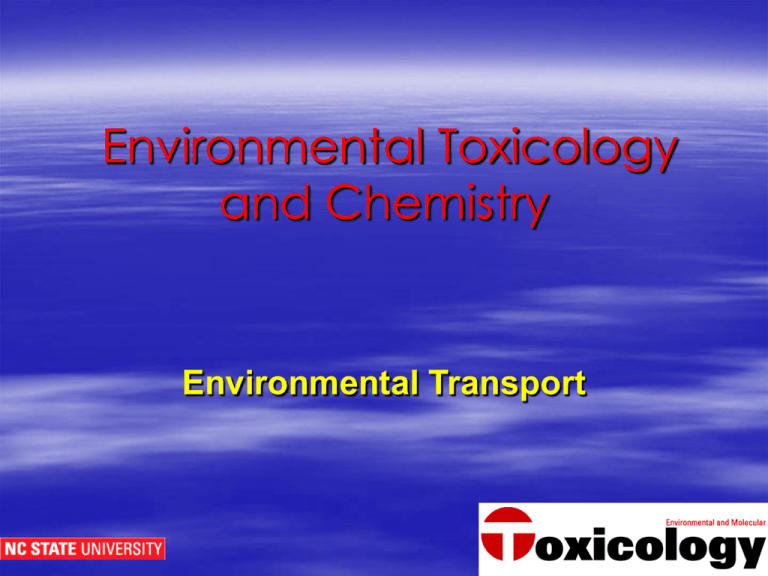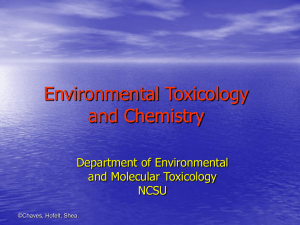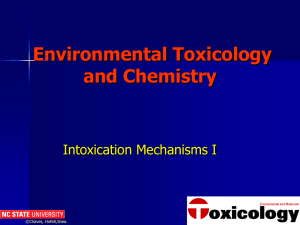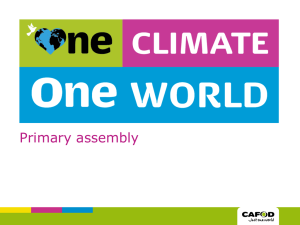Environmental Transport
advertisement

Environmental Toxicology and Chemistry Environmental Transport ©Chaves, Hofelt, Shea. Environmental Transport ©Chaves, Hofelt, Shea. Transport and Fate of Toxicants in the Environment ©Chaves, Hofelt, Shea. Dissipation ©Chaves, Hofelt, Shea. Dissipation ln (Co/C) = k1t t1/2 = ln 2/k1 = 0.693/k1 ©Chaves, Hofelt, Shea. Environmental Transport ©Chaves, Hofelt, Shea. Advection ©Chaves, Hofelt, Shea. Advection Refers to the passive movement of a chemical as part of its presence in a medium that is in movement itself. It can happen in the same compartment or between different compartments. ©Chaves, Hofelt, Shea. Homogeneous Advection J = Cvw where vw = flow rate and C = concentration. Example, consider water in a stream flowing at 1000 m3/h and carrying a chemical at 0.5 μg/m3. The chemical is being advected in water at a rate of 500 μg/h. ©Chaves, Hofelt, Shea. Heterogeneous Advection Refers to the case where there is a secondary phase present inside the main advective medium. Examples: particulate matter present in advecting river water, particles carried by wind. ©Chaves, Hofelt, Shea. Diffusion ©Chaves, Hofelt, Shea. Diffusion Random movement of chemical molecules due to the presence of a state of disequilibrium. It will transport chemicals from one place to the other one within the same compartment as well as between compartments until equilibrium is reached. ©Chaves, Hofelt, Shea. Intraphase Diffusion Two types of diffusional intraphase transport: molecular and turbulent diffusion. Molecular diffusion: movement of particles because of a concentration gradient. Turbulent diffusion: happens because of the turbulent mixing of the bulk medium. ©Chaves, Hofelt, Shea. Intraphase Diffusion Fick’s law: J = -D A(dC/dz) J = -kM AC ©Chaves, Hofelt, Shea. Interphase Diffusion Diffusion between two phases can be described using the following formula: J = kA(C1-C2K12) ©Chaves, Hofelt, Shea. Transport in and from Surface Water ©Chaves, Hofelt, Shea. Transport in Solution Advection Molecular diffusion Turbulent diffusion Dispersion ©Chaves, Hofelt, Shea. Transport in Solution Advection Molecular diffusion J = -Dm dC/dz Dm = 2.7 x 10-4/M0.71 cm2/s Dm1/Dm2 = M20.5/M10.5 Turbulent diffusion Dispersion ©Chaves, Hofelt, Shea. Water-Air Transport Transport between Water-Air J (moles/cm2/s) = KL (Cw – Ca/H’) C = Coe -KL t/Z T1/2 = 0.69Z/KL ©Chaves, Hofelt, Shea. Estimating Volatilization Rates from H’ ©Chaves, Hofelt, Shea. Transport on Particles Particle size Velocity Viscosity of the medium ©Chaves, Hofelt, Shea. Transport in Soil and Groundwater ©Chaves, Hofelt, Shea. Transport through Soil Vadose zone Saturated zone ©Chaves, Hofelt, Shea. Transport in the Vadose Zone Chemicals are able to migrate through the vadose zone by three main mechanisms: adsorbed to particles as gases (vapor) dissolved in solution ©Chaves, Hofelt, Shea. Transport through Groundwater ©Chaves, Hofelt, Shea. Atmospheric Transport Volatilization Advection Deposition ©Chaves, Hofelt, Shea. Volatilization J=k1(n/V)Dv/l J = k2(n/V)(1/M0.5)(M)/l = k3PM0.5/ lRT J mg/cm2/min= 0.029PM-2 ©Chaves, Hofelt, Shea. Advective Transport ©Chaves, Hofelt, Shea. Deposition ©Chaves, Hofelt, Shea. Deposition ©Chaves, Hofelt, Shea. Deposition J g/cm2/s = vgCa where vg is the deposition velocity and Ca is the atmospheric concentration ©Chaves, Hofelt, Shea. Global Transport ©Chaves, Hofelt, Shea. References 1-Crosby, D.G. Environmental Toxicology and Chemistry. 2000. Oxford University Press, New York. 2- Connell, D.W. Basic Concepts of Environmental Chemistry. 1997. Lewis Publishers, New York. ©Chaves, Hofelt, Shea.








